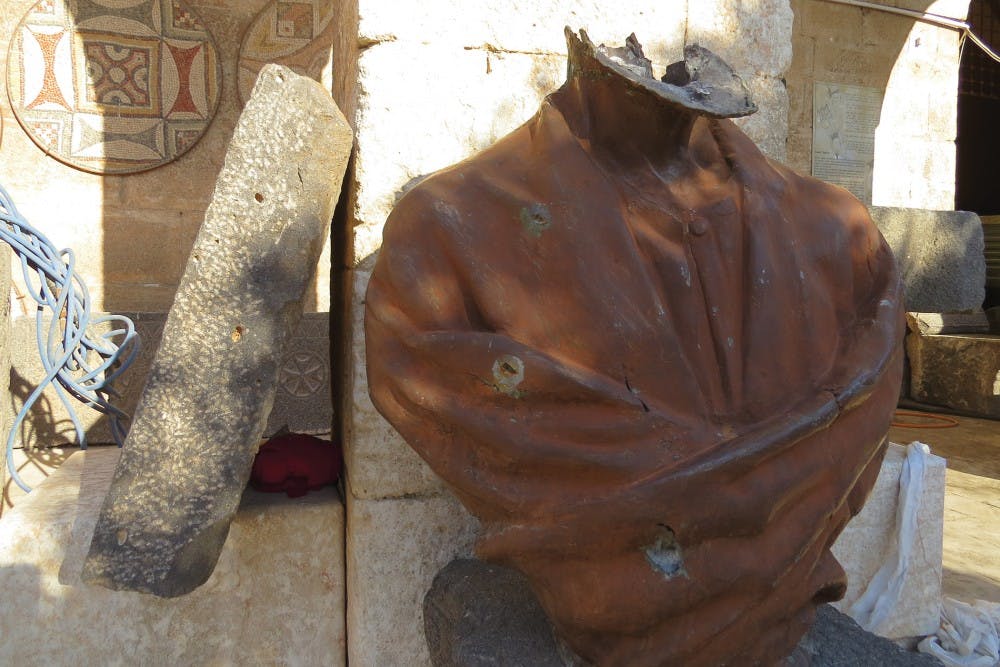The Syrian Civil War, which has devastated the nation since 2011, has not only exacted a heavy toll on the nation’s people, but also on the archives of its rich culture and history.
Cultural heritage sites such as historic cities, museums and archeological excavations, many of which are hundreds if not thousands of years old, have often been caught in the crossfire of the violence that has swept the nation. Some have even been specifically targeted by various factions and many have suffered significant damage, which is why the Penn Museum’s Cultural Heritage Center has been leading efforts to protect and document these historic landmarks.
The center has operated the Safeguarding the Heritage of Syria and Iraq Project since 2013, aiming to prevent future destruction to cultural sites in the region and enable local communities to repair and preserve damaged historic buildings.
“We really wanted to take some action, to do something that wasn’t just talking about the damage, it wasn’t just crying over spilled milk but rather was going and moving in the forward direction,” Penn Cultural Heritage Center fellow Katharyn Hanson said. “A lot of folks don’t think that action can take place on the ground while the conflict is going on, and much of the work going on that the Penn Cultural Heritage Center is involved in is really proving that action can take place,” she said.
“You can work with invested, brave local colleagues on the ground and get them the materials they need to move forward and make projects take place and make sure that heritage is protected and documented,” she added.
Last summer, the center worked with the Smithsonian Institution to put together a workshop entitled “Emergency Care for Syrian Museum Collections” for Syrian citizens dedicated to protecting these sites. The program served to enable the participants to effectively protect valuable museum possessions from potential looting and destruction.
“While it is very difficult for international heritage organizations to travel into Syria today, there are a number of Syrians who regularly risk their lives to protect their cultural heritage,” said Penn Cultural Heritage Center Director of Research and Programs Brian Daniels in a press release. “This workshop and other efforts going forward are designed to support these individuals and their efforts.”
The work and planning done at the workshop enabled Syrian volunteers and experts to complete the preservation of the Ma’arra Mosaic Museum in March 2015, a project organized by a consortium of international groups including the Penn Cultural Heritage Center and the Smithsonian. The effort involved reinforcing and protecting the mosaics in the building, which date back to the third through sixth centuries, and repairing the damage done to the building, according to a Penn Museum press release.
“We've seen how the invaluable cultural heritage of Syria has fallen prey to destruction by heavy artillery, targeted explosive attacks and looting as never before,” said Salam Al-Kuntar, a Syrian archaeologist and consulting scholar for the Penn Cultural Heritage Center, according to the press release. “We all know that what a group of dedicated Syrians have done is a small but meaningful act and a courageous act, taking difficult steps during wartime to preserve Syrian history for future generations. Let us hope that this will be the first of many more concrete efforts of preservation.”
Hanson said the work on the Ma’arra Mosaic Museum took place as a result of its representatives asking for assistance while at the workshop, adding that the Penn Cultural Heritage Center only takes on projects that local communities request.
“One of the important things about doing community work and working with colleagues in countries where you are coming in as an outsider is making sure that the projects that you’re doing are wanted by the community, and you’re working not as someone coming in with answers but working in connection with the community,” Hanson said.
The Penn Cultural Heritage Center’s efforts have also included a research component. Thanks to grants received from the National Science Foundation last year, the Center, the Smithsonian Institution and the American Association for the Advancement of Science have been building a database of the damage done to historical sites across the region. Combining ground reports, information from databases and geospatial data to identify and record structures that have sustained damage, the effort has located over 1,200 sites so far, according to the Penn Cultural Heritage Center’s website.
“This is really important as we move forward not just for the research angle of it: why does this happen? How does stuff get damaged during conflict? but also [for] the potential [use] when we think about documenting things in advance of war crimes prosecution,” Hanson said.
Hanson said that she hopes that the Center’s efforts are able to empower communities in the region to protect valuable, culturally significant sites and artifacts from the destruction that the conflict has caused.
“I hope that the impact is that we are able to help facilitate projects and work that our colleagues coming from the ground would want to have happen and we’re able to in some way both have these projects go forward to better protect sites and to document sites and also that we’re able to conduct research that will allow us to better respond to these situations in the future,” she said.



